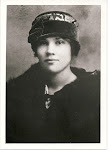September 6, 2010
Snapshot
Roy's next letter to Stella is not until early October, and while I am confident that my readers could figure out on their own that this large space between letters is due in part to the great distance between France and the United States (made greater by slower means of transportation and lack of e-mail), I thought I'd supply a bit of additional information about what was happening at this time in 1918 to Roy and to the Western World.
On September 3rd, the 281st aero squadron left the Pontanazen barracks (where they marched from Brest) and boarded a train for St. Maixent, where they arrived on September 4th. Unfortunately for the men, they arrived in the Port of Brest during or shortly after one of the worst outbreaks of Spanish Influenza, and when they arrived in St. Maixent roughly 40 of the men were ill with it, including, if we can believe his later letters, Roy Diehl. Between September 4th and 16th, the 281st stayed in St. Maixent, and when they boarded the train for Colombey-les-Belles, they left 15 sick men behind.
The Spanish Flu, a strain of H1N1 (familiar?), is largely forgotten, although it killed more people than the Great War itself did. It could be that the Great War has overshadowed the Spanish Flu as a greater event in history, but no doubt restricted media coverage of the illness due to the war as well as the brief (albeit intense) run of the disease between 1917 and 1918 contributed to its fading from human memory.
The Spanish Flu was an unusual pandemic in that it tended to be most dangerous for the hale and hearty, causing strong immune systems to react violently and kill the bodies they were trying to save. Thus, the young men heading off to war were often victims of the illness. Despite its name, the virus did not originate in Spain; Spain merely had few media restrictions, and therefore covered the virus in its newspapers etc. where other countries involved in the war did not. The virus is thought to have originated in the American midwest, though there were theories that it came from the Far East as well.
So, at this time in 1918, Roy and his squadron were traveling to their appointed location, and the Spanish Flu made a terrific comeback among the enlisted men while the Great War continued.
On September 3rd, the 281st aero squadron left the Pontanazen barracks (where they marched from Brest) and boarded a train for St. Maixent, where they arrived on September 4th. Unfortunately for the men, they arrived in the Port of Brest during or shortly after one of the worst outbreaks of Spanish Influenza, and when they arrived in St. Maixent roughly 40 of the men were ill with it, including, if we can believe his later letters, Roy Diehl. Between September 4th and 16th, the 281st stayed in St. Maixent, and when they boarded the train for Colombey-les-Belles, they left 15 sick men behind.
The Spanish Flu, a strain of H1N1 (familiar?), is largely forgotten, although it killed more people than the Great War itself did. It could be that the Great War has overshadowed the Spanish Flu as a greater event in history, but no doubt restricted media coverage of the illness due to the war as well as the brief (albeit intense) run of the disease between 1917 and 1918 contributed to its fading from human memory.
The Spanish Flu was an unusual pandemic in that it tended to be most dangerous for the hale and hearty, causing strong immune systems to react violently and kill the bodies they were trying to save. Thus, the young men heading off to war were often victims of the illness. Despite its name, the virus did not originate in Spain; Spain merely had few media restrictions, and therefore covered the virus in its newspapers etc. where other countries involved in the war did not. The virus is thought to have originated in the American midwest, though there were theories that it came from the Far East as well.
So, at this time in 1918, Roy and his squadron were traveling to their appointed location, and the Spanish Flu made a terrific comeback among the enlisted men while the Great War continued.
Subscribe to:
Post Comments (Atom)



Great posting. Knowing what was really going on with Roy compared to the upbeat mood of his letters gives them real poignancy. I did not know that the Spanish flu took such a toll.
ReplyDelete